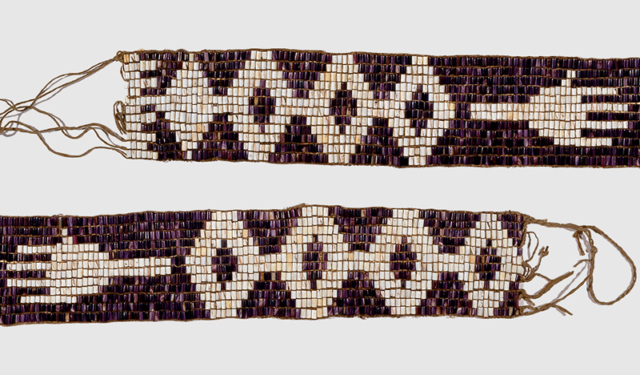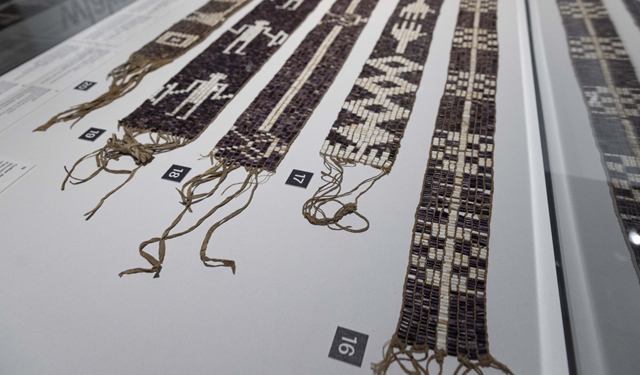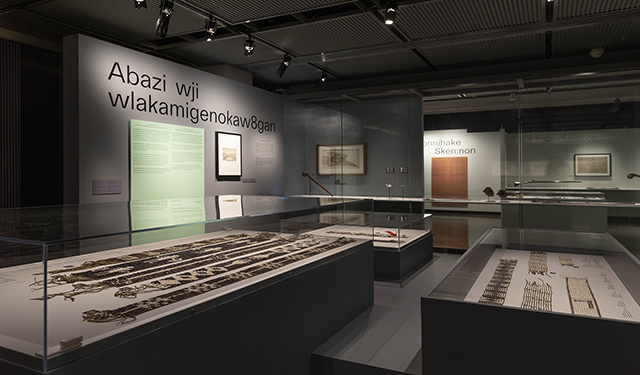[Day 1] International Symposium – Around Wampum: Histories and Perspectives
Six experts discuss the social, political and religious practices surrounding wampum in three seminars.
February 22, 2024
Capitalizing on the unprecedented interest generated by Wampum: Beads of Diplomacy, the Museum is organizing a symposium on February 22 and 23, 2024 devoted to these cultural objects, bringing together a dozen Indigenous, Quebecois, Canadian and international specialists.
These experts from various fields of research and intervention, will discuss the social, political and religious practices surrounding wampum in six seminars, presented over two days, through the prism of their multidisciplinary perspectives.
This recording includes the talks and the three panels from February 22, 2024. View the day’s program below, and browse the video using the available chapters to watch the session of your choosing.
Program – Day 1
| Panel 1 – Bringing Wampum to Life: From Indigenous Knowledges to Museums and Back | Moderated by Laura Peers, Oxford University, United Kingdom; Trent University, Canada | “Wampum Belts in France: A Forward-looking History,” Paz Núñez-Regueiro and Leandro Varison, Musée du quai Branly – Jacques-Chirac, France
“Literacy of Wampum: Understanding the Words it Carries,” Richard Hill Sr., Mohawk College, Canada |
| Panel 2 – Miigis Apikan (The Message is the Burden): Wampum in Anishinaabe Contexts | Moderated by Aaron Mills, McGill University, Canada | “The Materiality of Wampum,” Michael Galban, Seneca Art & Culture Center, Ganondagan State Historic Site, United States
“Their Bearing is Noble and Proud: Wampum as Ornament Among Native Americans,” Nikolaus Stolle, Goethe-Universität, Frankfurt-am-Main, Germany |
| Panel 3 – Wampum and Colonial State | Moderated by Yann Allard-Tremblay, McGill University, Canada | “Transatlantic Christian Wampums: A Multifaceted Diplomacy,” Lise Puyo, Université Paris Nanterre, France; University of Exeter, United Kingdom
“A Mi’kmaq Perspective on the Vatican Wampum Belt (1610-1831),” Stephen Augustine, Unama’ki College, Cape Breton University, Canada |
| Elder talk | Kanahsohon Kevin Deer, Kahnawà:ke, Canada |
Panel 1
WAMPUM BELTS IN FRANCE: A FORWARD-LOOKING HISTORY
Paz Núñez-Regueiro and Leandro Varison, Musée du quai Branly – Jacques-Chirac, France [ 11:48]
Several wampum belts from North America are now preserved in Paris, Chartres, Lille and Besançon. Originally, they represented the relationships forged between the First Nations and the French. Through troubled periods of national history, and under the growing weight of colonialism, these wampums have fallen silent, and most of the histories they embody have been lost. This presentation will recount the experience of a research project aiming to retrace the trajectory of these wampum belts, in partnership with First Nations members. Through such an approach, the production of knowledge also becomes the production of new relationships, perpetuating wampum’s role as a creator of alliances.
LITERACY OF WAMPUM: UNDERSTANDING THE WORDS IT CARRIES
Richard Hill Sr., Mohawk College, Canada [31:19 ]
This presentation will present the function of wampum from a Haudenosaunee point of view as a carrier of important messages. We will take a brief look at the origins and protocols of its use. We will then examine how wampum was/is used in treaty making and the visual symbols and metaphors that are used to assist the speaker in recounting their message. Finally, I will provide an overview of how the Haudenosaunee would ‘read’ the messages in the wampum belts in this exhibition.
Panel 2
THE MATERIALITY OF MEANING
Michael Galban, Seneca Art & Culture Center, Ganondagan State Historic Site, United States [1:17:30 ]
This session will focus on the varying methods of producing wampum as well as a short chronology of bead production. An exploration of technical systems Indigenous people employed to create wampum as well as a discussion on terminology will occur. A study of certain important wampum and their specific construction methods will be the focus of this session.
THEIR BEARING IS NOBLE AND PROUD: WAMPUM AS ORNAMENT AMONG NATIVE AMERICANS
Nikolaus Stolle, Goethe-Universität, Frankfurt-am-Main, Germany [1:43:19 ]
Wampum, or cylindrical white and purple shell beads, were used by Native Americans strung into strings or belts for diplomatic purposes. In addition to these communal documents, wampum also functioned as jewelry. These ornaments served two purposes: first they could function as symbols of status, making the wearer’s position publicly visible, or second as personal adornment. The following paper will focus on personal objects decorated with wampum, which have received little attention. First, an overview of the material will be given to explain the use of shell and later glass beads as ornament from the 17th to the 19th centuries. Based on these findings, their diversity and regional distribution among Native Americans will be discussed.
Panel 3
TRANSATLANTIC CHRISTIAN WAMPUMS: A MULTIFACETED DIPLOMACY
Lise Puyo, Université Paris Nanterre, France; University of Exeter, United Kingdom [2:31:32 ]
Between 1654 and 1831, a dozen wampum belts were donated to Catholic shrines in Europe. Travelling without an Indigenous diplomat, but accompanied by bilingual letters transcribing the words of a village council, these wampums were more than just objects of devotion to the Virgin Mary and Catholic saints. Their materials, their production processes and the words they embody reflect innovative diplomatic strategies, in a context where the Catholic Church was an important interlocutor in the French and then English colonial process in Canada. Shell beads arranged to write Latin phrases, studied in relation to the words ritually spoken to give wampums their mission, sketch out an Indigenous Christianity where kinship, religion and politics are intertwined.
These diplomatic artefacts are both transatlantic and local, providing valuable insight into the territories and alliances of the St. Lawrence Valley’s Indigenous peoples. Only four still exist today, and some have continued their diplomatic careers beyond their first exchange. At times misused or revived, these still-active wampum belts have forged new alliances or rekindled old relationships.
A MI’KMAQ PERSPECTIVE ON THE VATICAN WAMPUM BELT (1610-1831)
Stephen Augustine, Unama’ki College, Cape Breton University, Canada [2:56:59]
This presentation will focus on the Vatican Wampum Belt that was sent to Pope Gregory XVI in Rome in 1831 from the Sulpician Missionary in Oka at Lake of the Two Mountains in Quebec. Stephen Augustine will give a Mi’kmaw perspective according to the oral testimony of his grandmother Agnes (nee Thomas) Augustine born June 14, 1898, and died December 6, 1998, at the age of one hundred years old.
Agnes’ story reflects, according to her interpretation, the baptism of Grand Chief Membertou at Port Royal, in Nova Scotia, on June 24, 1610. Her interpretation is based, solely, on a photograph of the belt taken by an American anthropologist, David Bushnell, in the early 1900s. She had never seen the actual belt. He showed her the photograph asking her if she knew about the belt. Agnes begins her story with the Mi’kmaw Creation Story, an oral traditional story passed down through generations of the Alguimou chiefs who later were baptized in 1747 by a Catholic priest giving the family the name Augustine. Stephen is a descendant of this line of Mi’kmaw chiefs and is called a Hereditary Chief.
Elders
KANAHSOHON KEVIN DEER
Allocution by Kanahsohon Kevin Deer, Kahnawà:ke, Canada [3:40:40]
Kanahsohon Kevin Deer is from Kahnawà:ke, Mohawk Territory. For the last 30 years he has been involved in Mohawk Language retention and revitalization. He is also a Faithkeeper at the Mohawk Trail Longhouse which involves knowing sacred songs, dances and rituals. He enjoys discussing and presenting the Iroquoian world views, history and philosophy. He was involved in the Kahnawà:ke Police Commission from 2005 to 2015.
In 1990 he was involved in the Oka Crisis using the power of peace to try to resolve that conflict. In May 1990 he participated in a ceremony calling for the return of the Peacemaker in Tyendineaga, Ontario. In 1994 he assisted in the establishment of the new Mohawk community at Kanatsiohareke, New York. In 2003 he was part of a planning committee of the historic event that involved horses coming across the land from British Columbia to Six Nations to help wipe the tears of the 7 generations and heal the earth. In September 2015 he was deeply involved in the Bretton Woods IV convocation, performing a ceremony to help all participants who gathered to see, hear, and speak more clearly about matters of global financial concern from a Native, First Nation’s perspective. In February 2016, he made a presentation on Native spirituality at the United Nations World Interfaith Harmony Week in New York. In August 2016 he did a welcoming and healing ceremony for the World Forum on Theology and Liberation in Montreal. In November 2016 he travelled to Standing Rock to meet with spiritual leaders and elders.
MODERATORS
Laura Peers
Dr. Laura Peers has opened dialogues between Indigenous communities in North America and museums across the UK, Europe and North America. As a historian and museum anthropologist as well as a curator, her research and curatorial practice has focused on historic Indigenous cultural items, and she explores both the detailed histories of items in museum collections and the meanings of heritage objects to Indigenous people today. Laura has managed complex international projects linking museums and Indigenous communities, including the Great Box Project with the Haida Nation, the Blackfoot Shirts Project with all four Blackfoot Nations, and recently the To Honour and Respect project with the six Mississauga Nations. She has surveyed historic wampum in UK collections. She is Emeritus Curator, Pitt Rivers Museum, and Emeritus Professor of Museum Anthropology at the University of Oxford, and Adjunct Professor in the Graduate Faculty, School for the Study of Canada and Department of Anthropology, at Trent University.
Jonathan Lainey
Jonathan Lainey, Curator, Indigenous Culture, joined the McCord Stewart Museum in 2020. He studied anthropology and Indigenous studies and holds a master’s degree in history from Université Laval. His research interests include the social, political and cultural history of the Indigenous Peoples of Quebec and Canada as well as the history of objects and collections over time, particularly wampum belts. He has served as Curator, First Peoples, at the Canadian Museum of History in Gatineau as well as Archivist, Indigenous Archives, at Library and Archives Canada.
He has published two books, helped develop exhibitions, and written numerous articles, publications and research reports.
Jean-François Lozier
Jean-François Lozier has been Curator of French North American history at the Canadian Museum of History since 2011. He holds a Ph.D. from the University of Toronto (2012) and an M.A. from the University of Ottawa (2004). Between 2016 and 2020, he served as assistant professor at the Department of History of the University of Ottawa. He has authored a number of articles as well as Flesh Reborn: The Saint Lawrence Valley Mission Settlements through the Seventeenth Century (McGill-Queen’s University Press, 2018).
SPEAKERS
PAZ NÚÑEZ-REGUEIRO
As Head Curator of Heritage, Paz oversees the Heritage Unit of the Americas collections at the Musée du quai Branly – Jacques Chirac. With a background in Art History, Archaeology and Museum Studies, she received a Doctorate in Art History from the University of Paris I Panthéon-Sorbonne in 2018. Her thesis, published under the title Promises of Patagonia: French exploration in South America and the patrimonialization of the ‘end of the world’ (Presses Universitaires de Rennes, 2022), was awarded the Prix Delavignette of the Académie des Sciences d’Outremer.
She has extensively researched aspects of pre-Hispanic and contemporary societies. She is particularly interested in the ways Native American collections have been collected, studied, and exhibited since their arrival in Europe, and in their historical, cultural and political legacies now and in the past.
LEANDRO VARISON
Leandro is Head of International Research in the Research and Teaching Department of the Musée du quai Branly – Jacques Chirac. After obtaining a dual degree in law and anthropology at the University of São Paulo, in his native Brazil, he defended a doctoral thesis in the anthropology of law at the Université Paris 1 Panthéon-Sorbonne, where he taught from 2015 to 2019. Leandro has been working with Indigenous organizations, especially at the international level, for over ten years. His research focuses on the rights of Indigenous peoples, intellectual property and the protection of traditional knowledge and cultural expressions.
RICHARD HILL SR.
Richard Hill Sr., Beaver Clan of the Tuscarora Nation, resides at the Six Nations of the Grand River Territory. He has been involved in the recovery and interpretation of wampum since 1974, working with the Grand Council of Chiefs of the Haudenosaunee Confederacy. Through the Standing Committee on Repatriation/Rematriation he has been able to gain access to most of the wampum collections in North America, and working with Chiefs, Clan Mothers and community knowledge holders, has been able to reweave a connection to the various wampum strings and belts that ensure the cultural fluency of wampum.
Having formerly served as Assistant Director at the National Museum of the American Indian of the Smithsonian Institution and Assistant Professor at the State University of New York at Buffalo, he currently works as Indigenous Innovations Specialist at Mohawk College, Hamilton, Ontario.
MICHAEL GALBAN
Michael Galban (Wašiw (Washoe) & Kutzadika’a (Mono Lake Paiute)) is the Historic Site Manager of Ganondagan State Historic Site and the curator of the Seneca Art & Culture Center. Ganondagan is a 17th century Seneca town site and nationally regarded as a center for Iroquoian history, cultural and environmental preservation. His academic research focus is on Woodland Indian art/aesthetics, Indigenous semiotics and situated regard. Michael is currently enrolled in the Visual and Cultural Studies PhD program at the University of Rochester.
He sits on the board of directors of the Museum Association of New York, and on the editorial boards of the New York History and Rochester History Journals. Michael is currently working in the Indigenous Working Group component of the REV WAR 250th NY commission. Michael recently collaborated with the Musée du quai Branly – Jacques Chirac on the exhibit Wampum : Perles de diplomatie en Nouvelle-France which opened Spring of 2022 in Paris, of which the corpus of the exhibition traveled to Ganondagan in 2023 as “WAMPUM/OTGO:Ä” and is currently on exhibition at the Musée McCord Stewart.
NIKOLAUS STOLLE
Nikolaus Stolle is an anthropologist specialized in North American history and Native American cultures. He is curator for the Americas at the Linden-Museum Stuttgart, Germany, and contributes to the joint initiated research project CRoyAN (Collections Royales d’Amérique du Nord) at the Musée du quai Branly – Jacques Chirac at Paris since 2019. He has lectured at the Ruprecht-Karls-Universität, Heidelberg, and the Goethe-Universität, Frankfurt-am-Main, Germany, where he received his Ph.D. in 2013 (published in 2016 and titled Talking Beads – The History of Wampum as a Value and Knowledge Bearer, From its Very First Beginnings Until Today). Since 2010 he also contributes to the international research project GRASAC (Great Lakes Research Alliance for the Study of Aboriginal Arts and Cultures).
LISE PUYO
Lise Puyo holds a doctorate in anthropology and is interested in how objects associate, link or separate human communities. After studying transatlantic Christian wampum belts, she joined a research team from the labex Les passés dans le présent (Université Paris Nanterre) and the University of Exeter, investigating contested statues linked to colonial history in France and England.
STEPHEN J. AUGUSTINE, CM, DHC ÈS L., ALGUIMOU
Stephen Augustine is a Hereditary Chief on the Mi’kmaq Grand Council. He is the Executive Director of the Marshall institute and the former Associate Vice-President Indigenous Affairs and Unama’ki College at Cape Breton University. Previously he was the Curator of Ethnology for Eastern Maritimes at the Canadian Museum of Civilization. He holds a master’s degree in Canadian Studies from Carleton University focussing on traditional knowledge curriculum development in the context of the education system and a Bachelor of Arts in Anthropology and Political Science from St. Thomas University. Stephen was recently appointed to the Order of Canada, C.M., for advancing Mi’kmaq studies, and for sharing his scholarly expertise and traditional knowledge with private and public organizations across Canada.
In 2022, Stephen was awarded an Honorary doctor of letters from the University of New Brunswick recognising his dedication to supporting education through Indigenous ways of knowing and fostering an environment for collaboration between organizations. In his role as a Hereditary Chief on the Mi’kmaq Grand Council and by Elders’ training since an early age, Mr. Augustine has a thorough command of traditional practices, his language and the history of his people.



